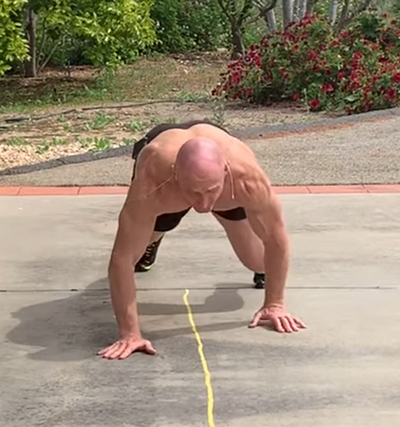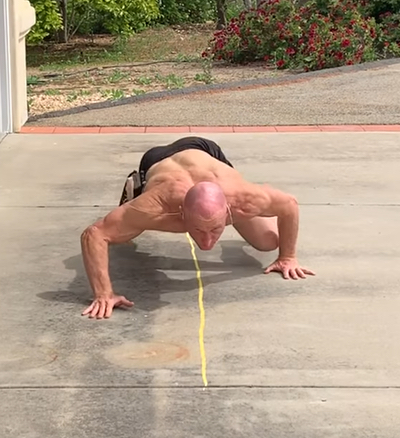The Bear Walk and Reptilian Crawl
 Happy Monday! We’re back to Dr. Movement, and I have a special treat for you…
Happy Monday! We’re back to Dr. Movement, and I have a special treat for you…
This week’s blog/vlog features the Bear Walk and Reptilian Crawl, two simple infant development exercises among many taught in Advanced Training Programs at the CHEK Institute, including CHEK Practitioner Level 1.
Typically, I don’t share infant development exercises on my blog/vlog for one very important reason: These exercises have to be done with very good technique or you’ll train the body at a very deep level to move incorrectly.
The Bear Walk and Reptilian Crawl are safe to do, IF you do it with good technique and you’re in good shape (so you won’t hurt yourself).
In my video. I’ll show you what good technique means, how to do the Bear Walk and Reptilian Crawl and some variations to make it more playful and dynamic.
The Bear Walk
The Bear Walk is much like children crawling to the point that they position their butts in the air. The higher your butt is in the air, the easier it’ll be for you.
I recommend starting out going nice and easy and keeping it comfortable, especially when you’re warming up and just make it playful.
 As you’re crawling, be sure to draw your umbilicus in just enough to stabilize your core. You don’t need to suck it in tight. Remember, as more load is going through your core, the more activation of the deep abdominal wall or transverse abdominis you’ll need.
As you’re crawling, be sure to draw your umbilicus in just enough to stabilize your core. You don’t need to suck it in tight. Remember, as more load is going through your core, the more activation of the deep abdominal wall or transverse abdominis you’ll need.
The more you draw the belly inward, the more it activates the diaphragm, the pelvic floor and the deep stabilizers of the spine because they’re all neurologically linked together.
Guys can easily test this by poking their index finger into their belly button and tightening their rectum. Women can do the same thing by placing their index finger in their belly button and doing a Kegel exercise to contract, then relax their pelvic floor.
If your belly button doesn’t fold inward, that’s a very important indicator you have a more serious core disintegration problem, and you’re highly susceptible to injury doing functional exercises, weightlifting, typical gym stuff and even aerobic exercise.
If this is difficult, get some help from a trained CHEK Professional who is an expert in assessing and correcting core dysfunctions through the CHEK Connect webpage.
Another thing to keep in mind, even with a simple infant development exercise like this one: Once you start getting fatigued to the point that you’re having a hard time maintaining good form, STOP.
If you go one rep past good form, that extra stress exerts the most influence on your body. So, if you’re doing 10-15 reps and your last three reps are done with bad form and you’re feeling pain, your brain won’t remember all the good technique you used up to the point things went bad.
Your brain will be traumatized by those bad reps. Pain is the most powerful reprogramming agent in the human nervous system.
You see it all the time in the gym with people training like teenagers with too much testosterone and they’re all over the place. Sometimes, you can’t tell who’s working out harder: The spotter or the guy doing the weightlifting.
That’s extremely bad conditioning and can cause problems that can take months, if not years in therapy to fix through corrective exercise.
The Reptilian Crawl
 Let’s take this exercise a bit further with the Reptilian Crawl, which is different than the Bear Walk in that you’re increasing the load by getting your butt much closer to the ground.
Let’s take this exercise a bit further with the Reptilian Crawl, which is different than the Bear Walk in that you’re increasing the load by getting your butt much closer to the ground.
The Reptilian Crawl requires much more core stability, so be sure you can draw your belly button inward — turning your core on — but still be able to breathe diaphragmatically so your spine is supported.
In my video, you probably noticed that I’ve drawn a yellow chalk line on the driveway. When I work with clients to perform this exercise, I’ll tie a piece of cord or string around their waists with a weight on it, then tell them to move in order to keep that cord right on that line.
That trick helps my clients train their brains to move their primary stabilizer muscles properly.
When people try to do this gym — most often with bad form — you’ll see their butts are wandering from side to side, and not in a straight line.
Again, this means your outer unit systems — your prime movers — are overworking the stabilizer system and you cannot maintain good joint integrity.
If you want more general help, I talk about core stabilization and proper recruitment of the core muscles in my book, How to Eat, Move and Be Healthy! And, if you want to learn a great deal more — for example, how to assess your form, optimize your performance and remain injury-free — consider my Scientific Back Training and Scientific Core Conditioning correspondence courses.
If that’s not enough for you, think about taking my CHEK Exercise Coach and Holistic Lifestyle Coaching (HLC) programs. You can even take HLC 1 online in the comfort of your home and at your pace too!
See you soon…
Love and chi,
Paul














Recent Comments